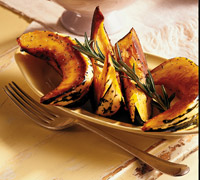Insights by Goldie: Emperors of the garden, royalty on the table
by Goldie Caughlan
This article was originally published in December 2004
The extraordinary variety of hard-shelled winter squashes, gourds and pumpkins (all members of the broad Cucurbitaceae family) could be summed up in one word: Askutasquash. And no, that wasn’t a sneeze; just an early Native American word that evolved into our word, “squash.” Curiously, it is said to have meant “green-raw-unripe,” which is how it was eaten at the time, and which we seldom do today. Years ago I dried strips of raw winter squash for additions to stews or soups, but I also nibbled some like jerky and found they have a pleasant taste and chewy texture.

Winter squashes, in general, are far more nutritious than summer varieties, such as zucchini. The typically yellow or orange pulp is rich in vitamin A, an important antioxidant. I seldom remove the peel of pumpkin or squash, except to occasionally discard the dark green skin if I want to preserve the bright yellow color of the purée, as in a soup or pie. Most squash skin is tender when cooked, and since the skin of vegetables contains much of the fiber, flavor and nutrients, why waste it?
Spaghetti squash skin is usually discarded after steaming or baking, since the soft pulp is “raked” from the shell with a fork, yielding a mound of fluffy spaghetti-like strands to top with pasta sauce or just garlic, olive oil and cheese. Kids love it!
The multi-colored, double-decker Turban squash shell does not tenderize, but this actually is an advantage. It makes a beautiful centerpiece in its own dish, which can include a fruited grain pilaf or bread stuffing similar to poultry stuffing. Another possibility is to scoop out the tender pulp close to the shell and make a puréed soup. Meanwhile, wipe out the shell and return it to a warm, not hot oven, until thoroughly dried and hard. Use it as a lovely natural soup tureen to serve it’s own creamy soup.
It can be daunting to cut raw, hard-shelled squash, no question about it! What to do? Bake it whole, either until it “gives” slightly with light pressure, or bake completely. When sufficiently cooled, discard pith and seeds. If not fully tender, return it to the oven (now covered with foil), until done. Usually I bake squash at 350° to 400° F. Cut raw squash can be steamed, boiled or baked.
Serve in cut chunks, or prepare as you would mashed potatoes. Any left-over puréed pulp can be frozen in one- or two- cup portions for later use in cookies, muffins, breads, soups, or everyone’s favorite, pumpkin (or squash) pie. In fact, did you know that most canned “pumpkin” is actually squash?
The human family has appreciated these marvelous vegetables for millennia. The archaeological record of pre-Columbian peoples of Mexico and Central America, dating from 7,000 B.C. reflects the culinary and cultural importance these ancients associated with gourds and squash. They especially revered the beauty of the mystical male and female flowers, as depicted in numerous artistic and cultural artifacts.
Chinese writers in the 7th century B.C. referred to squash as “Emperors of the Garden.” I initially saw this as evidence of great respect and veneration. On further reflection, I also recalled the awesome growing power of squash, whose fast-spreading vines and tendrils imperiously overran my garden each year, expanding their territory and nudging out their neighbors. I believe the witty Chinese observers intended to convey a secondary meaning to the term, “emperor of the garden.”
Winter squash textures, similar to potatoes, fall into two classes: some are rich and mealy and somewhat dry, while others are smooth and buttery. In general the mealy squash include Acorn, Buttercup, Blue, Hubbard, Kabocha, Kuri and pumpkins. Smoother, generally buttery types include Butternut, Delicata and Sweet Dumpling. My personal favorites are Buttercup, Kabocha and Kuri, mashed or in soups or pies, and Delicata or Sweet Dumpling, steamed or roasted in slices, or diced in stir-fry.
